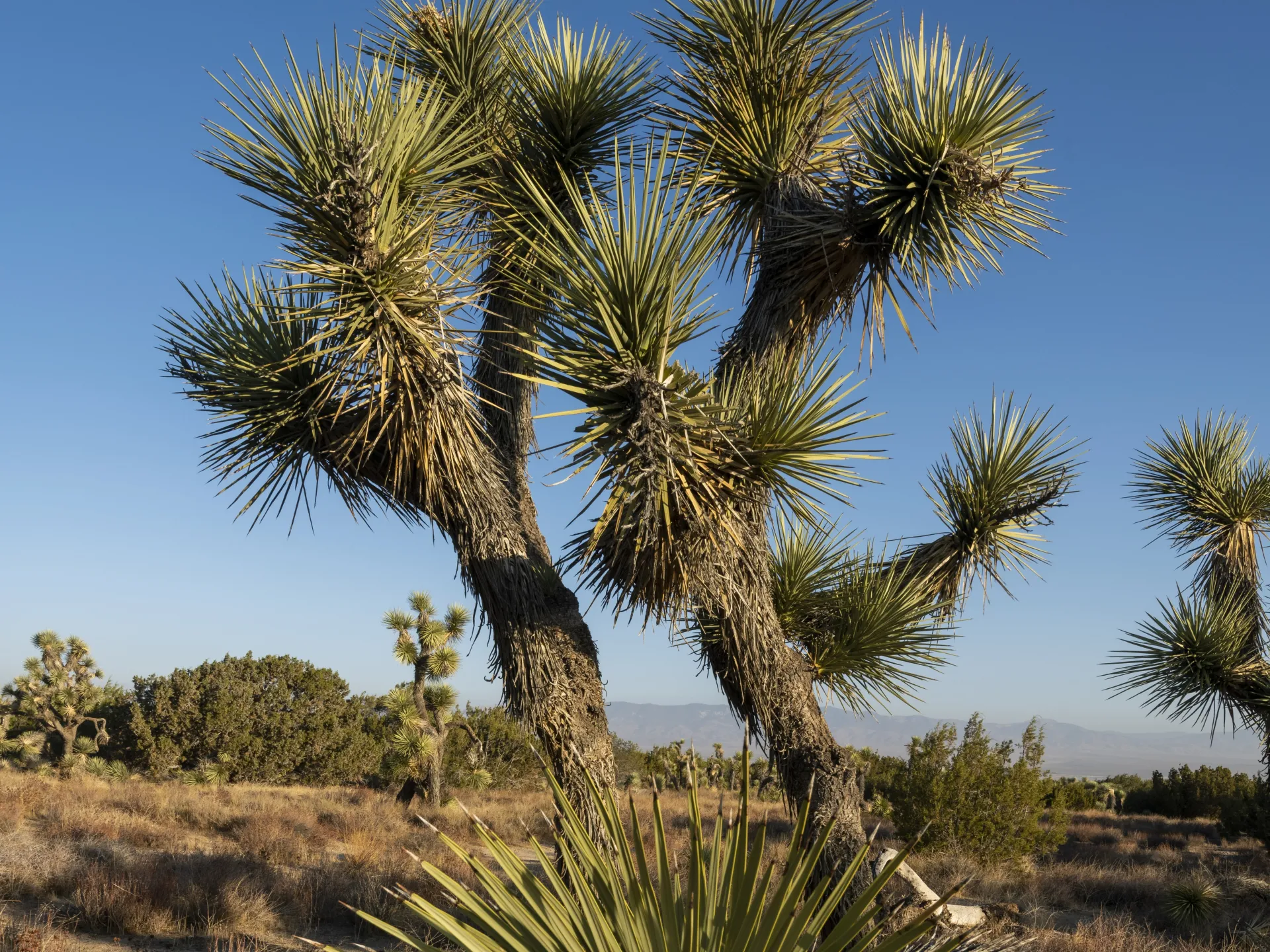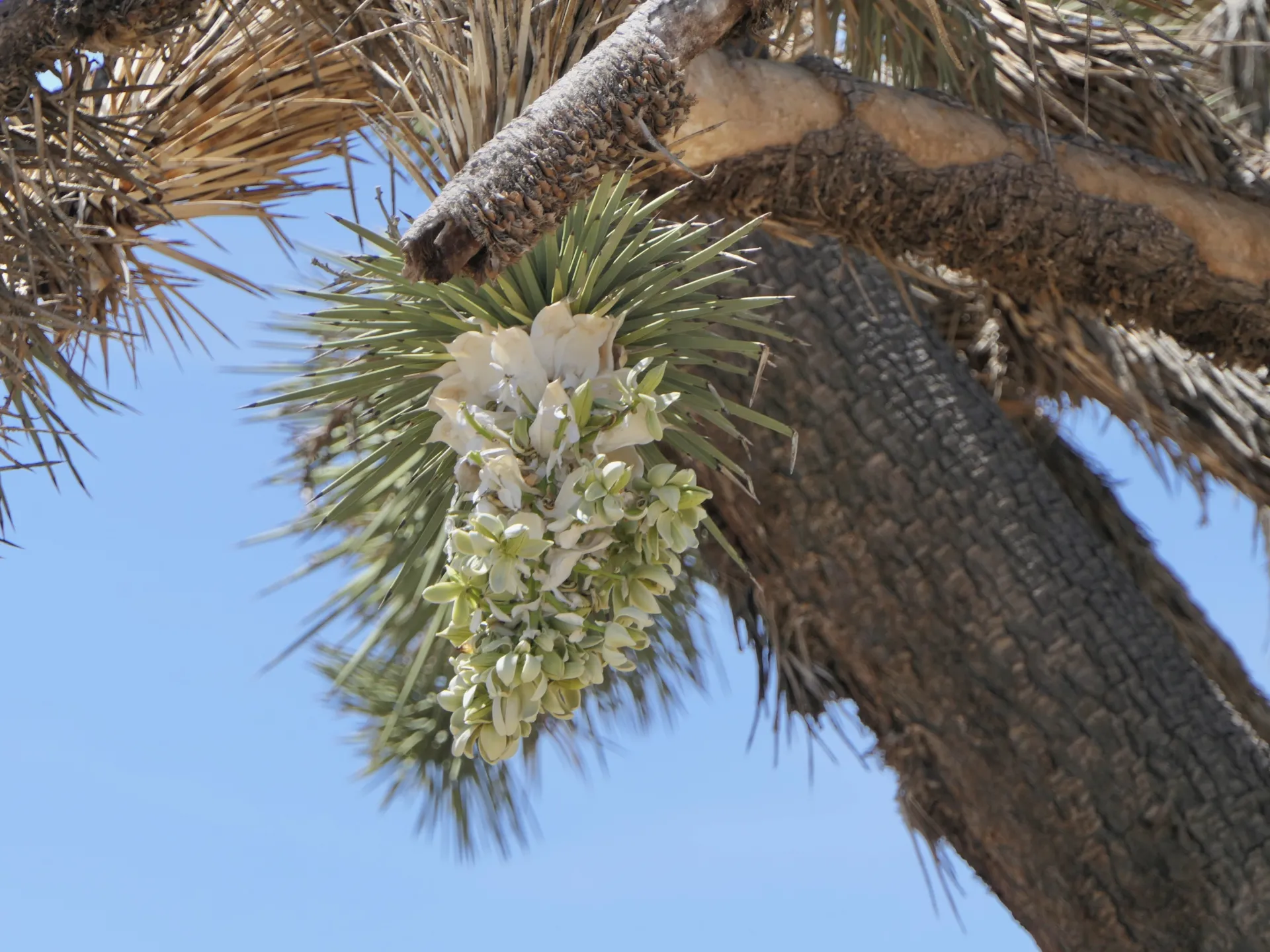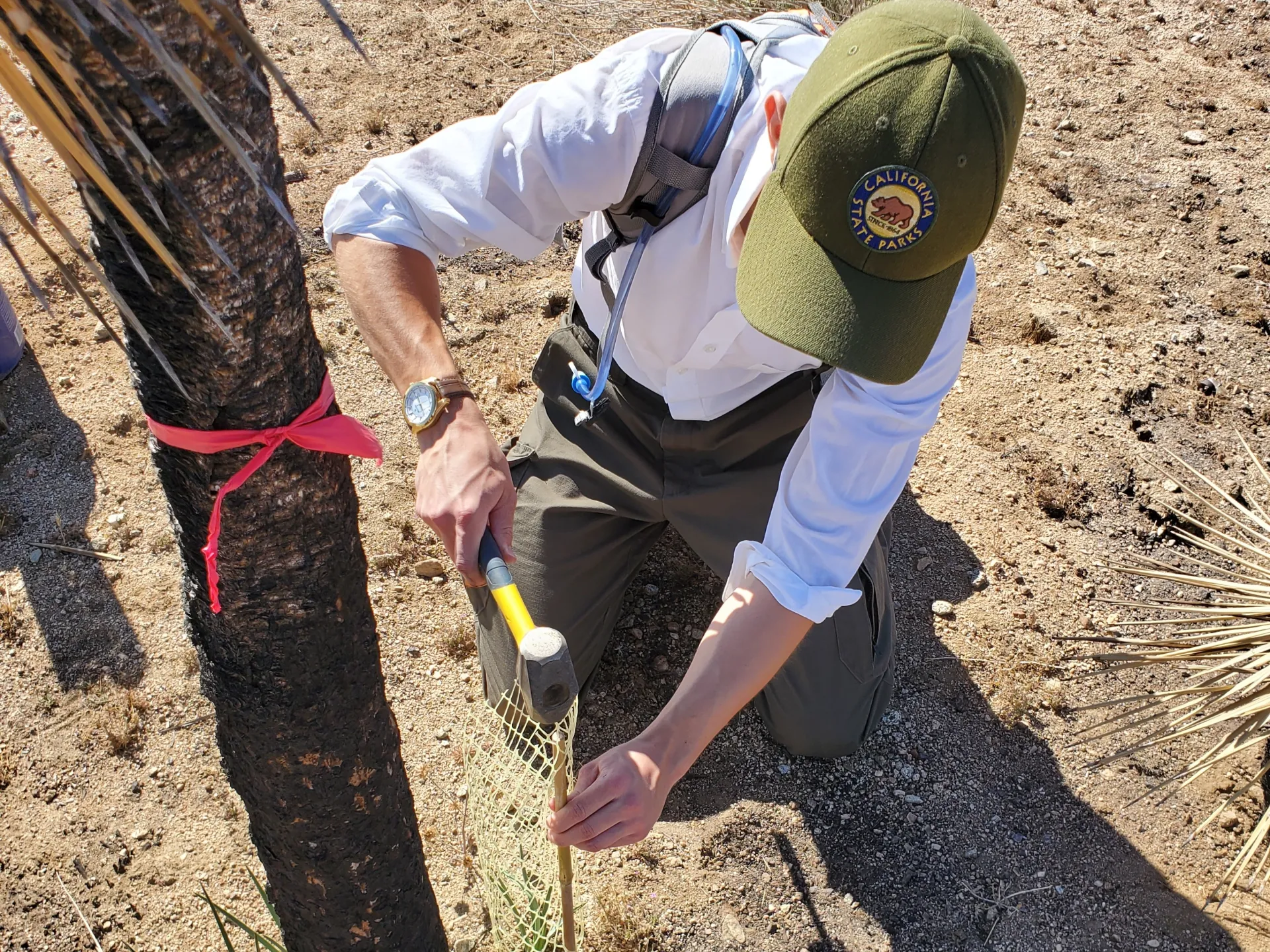By Dr. Emily Doyle.
Joshua trees have spanned California’s deserts for centuries. In fact, Joshua trees may be one of the desert’s “oldest living plants,” and one tree in California has been estimated at over 1,000 years old. When many people think of Joshua trees, Joshua Tree National Park immediately comes to mind, but these majestic trees also call state parks home. Unfortunately, Joshua trees are increasingly threatened by rising temperatures, prolonged drought, and other impacts of climate change. In response, California State Parks Foundation continues to support critical research in Arthur B. Ripley Desert Woodland State Park, where visitors can explore mature stands of Joshua trees and California juniper trees. By learning more about how Joshua trees respond to the effects of climate change, we can help protect this iconic species for future generations.
How are Joshua trees being affected by climate change?
Joshua trees can live hundreds of years and reach over 30 feet into the sky. However, their survival is heavily dependent on a specific climate — including well-timed precipitation, hot summers, and cold winters, with temperatures ranging from -13 °F all the way to 120 °F. Suitable habitat is typically found at elevations between 2,000 and 6,000 feet. A cold period is essential for Joshua trees to flower and reproduce, and years with higher rainfall may be best for flowering. Freezing temperatures damage the growth end of a branch, which counterintuitively causes branching and flowering and allows future pollination and propagation. This process explains why some Joshua trees are straight up and down while others branch in multiple directions.
Because of this dependence on cold, Joshua trees are particularly susceptible to the effects of climate change. As temperatures increase, available habitat is shrinking as lower elevations become too warm and dry, and trees are less able to flower and reproduce. Furthermore, though they are adapted to the desert, Joshua trees are also dying from prolonged drought. In fact, some researchers believe that Joshua trees may completely disappear by the end of the century due to the effects of climate change.
Joshua trees are also threatened by extreme climate events. Due to climate change and over 150 years of fire suppression, we are seeing an unprecedented increase in the frequency, size, and severity of wildfires. Some research suggests that Joshua trees can survive certain types of wildfire due to fire-resistant bark, and significant post-fire resprouting from the roots and branches of surviving trees has been observed. However, other studies have reported that Joshua trees die if burned, and we are already seeing the catastrophic effect of severe wildfires on California’s Joshua trees. Because of these various responses, continued research is essential to learn more about fire ecology in desert environments and how it relates to Joshua tree conservation and resilience.
In 2020, over one million Joshua trees were killed in the Lake Fire and Dome Fire in the Mojave Desert. Like many desert species, Joshua trees grow slowly — gaining only one-half to three inches every year — so burned areas take a long time to recover, particularly when also stressed by extreme heat and drought. This combination of increasing climate threats and slow recovery means that we must act now to protect these magnificent trees.
Legal protections for California’s Joshua trees
In addition to climate change, Joshua trees are threatened by development, such as constructing new neighborhoods and roadways. Interestingly, many Joshua trees in the Antelope Valley were cut down to make movie sets in the early 20th century. Today, ~40% of Joshua trees’ range is on private land and, prior to 2023, had little protection from development.
The combined threat of development and climate change has spurred legal action to protect Joshua trees in California. In 2019, the Center for Biological Diversity petitioned the California Fish and Game Commission (CFGC) to protect Joshua trees under California’s Endangered Species Act. As a result, CFGC designated Joshua trees as candidates for protection and placed them under interim protection until a final decision could be made after further research. However, the Commission deadlocked in 2022 about officially protecting the species under the state’s Endangered Species Act, and the California Department of Fish and Wildlife declined federal protection in 2023.
Fortunately, advocates continued the fight for the survival of this beloved species, and California passed the Western Joshua Tree Conservation Act in 2023. This legislation prohibits the removal or killing of trees without a permit, requires the development of a conservation plan, creates a fund to acquire and protect Joshua tree habitat, and more. However, as the climate crisis accelerates, we must continue to learn all we can about Joshua trees — and how they will respond to their changing environment — in order to prepare and protect these Joshua trees as much as possible.
How is California State Parks Foundation working to protect Joshua trees and what have we learned?
California State Parks Foundation is working to ensure the survival of California’s Joshua trees by supporting critical work in Arthur B. Ripley Desert Woodland State Park, home to over 560 acres of Joshua trees. Sadly, in 2020, the Lake Fire burned 55 acres of the park, killing a large number of mature trees.
“The story of Arthur B. Ripley Desert Woodland State Park is a prime example of how climate is impacting our resources and land,” said Luis De Vera, an environmental scientist in California State Parks’ Great Basin District. In the wake of the Lake Fire, California State Parks Foundation was proud to fund restoration work to promote the recovery of Joshua tree habitat. However, we must also look beyond restoration to develop resilience strategies to protect Joshua trees in the future.
With the continued support of California State Parks Foundation, California State Parks has been conducting a multi-year study examining how Joshua tree sprouts are recovering after the Lake Fire. Beginning in 2021, they identified, put protective cages over, and monitored over 700 young Joshua trees that had sprouted after the area was burned. When resurveyed one year later, almost half of the sprouts had survived, and over 400 more were identified. In fact, a small number of burnt Joshua trees had begun to produce seeds, showing beginning signs of recovery.
Learning how ecosystems recover is key to stewarding land to increase climate resilience. “There has been a lack of research understanding how Joshua trees have been impacted by wildfire and how they recover,” said De Vera. “With this baseline study, we can explore options in managing our Western Joshua trees and other resources in our parks against climate.”
By supporting this important research, California State Parks Foundation is helping California State Parks take a critical step in the fight to protect Joshua trees from climate change. In addition to the long-term impacts of climate change, California State Park Foundation recognizes the importance of immediate action to protect Joshua trees from severe climate events like wildfire. Through our latest 2024 Building Climate-Resilient State Parks grant, we are providing funds for a fuels reduction project at Arthur B. Ripley Desert Woodland State Park to remove invasive species and reduce the risk of another severe wildfire.
The future of California’s Joshua trees
There are an estimated 4 to 11 million Joshua trees growing across Southern California, and their survival is not guaranteed. The devastating effects of climate change are clear, and millions of trees are already facing the consequences. However, California State Parks is taking action to protect the beloved Joshua trees that call state parks home and, though the challenge may seem overwhelming, we must face it head on. As the climate threat grows, California State Parks Foundation will fight for the survival of this iconic species by working with California State Parks and other park partners. By championing these critical efforts, California State Parks Foundation will continue its mission to preserve state parks — and the amazing wildlife they protect — for generations to come.
Celebrate Giving Parksday! Make a gift now through Tuesday, December 3 and help us create a lasting impact for our parks and the incredible plants and animals that call them home.
To learn more about how climate change is affecting state parks and how we can take action, check out our trailblazing report, Building a Climate-Resilient California State Park System: Preserving Parks for Future Generations. You can also donate to fund our grant programs, like the 2024 Building Climate Resilient State Parks grant round that is supporting this important work.
Sources:
- https://books.google.com/books?hl=en&lr=&id=ZZHygFQAm8UC&oi=fnd&pg=PA10&dq=Southwestern+Trees:+A+Guide+to+the+Native+Species+of+New+Mexico&ots=383QipJNFT&sig=iamLhp642SLu_9CSeTZN1VFZcsQ#v=onepage&q=Southwestern%20Trees%3A%20A%20Guide%20to%20the%20Native%20Species%20of%20New%20Mexico&f=false
- https://scholarship.claremont.edu/cgi/viewcontent.cgi?article=1206&context=aliso
- https://www.npr.org/2023/07/05/1186098950/californias-plan-to-save-the-western-joshua-tree-which-is-in-danger-due-to-droug
- https://www.sfgate.com/la/article/joshua-tree-alternative-saddleback-19438487.php
- https://leginfo.legislature.ca.gov/faces/billTextClient.xhtml?bill_id=202320240SB122
- https://www.fs.usda.gov/database/feis/plants/tree/yucbre/all.html#62





